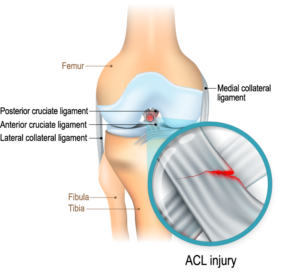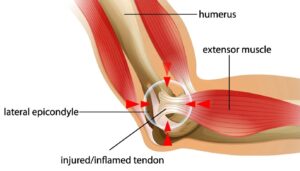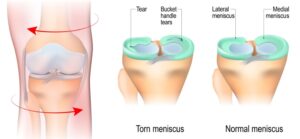Orthopaedic injuries are injuries to the musculoskeletal system of the body. In other words, orthopaedic injuries are injuries to the bones, cartilage, tendons, ligaments, etc.
Types of orthopaedic injuries:
Some of the common orthopaedic surgeries are tennis elbow, ankle sprain, fractures, shoulder dislocations, meniscus tear, anterior cruciate ligament (ACL) tear, plantar fasciitis, etc.
Anterior Cruciate Ligament (ACL) Tear: Causes, Symptoms, and Treatment
ACL is one of the strong tissue bands that help connect our femur (thigh bone) to the tibia (shinbone). ACL tears usually occur during sports that involve jumping, a sudden stop, or a sudden change in direction.

Causes of ACL tears are:
- Making sudden changes in directions, like taking a sharp cut.
- Receiving a direct impact or collision to the knee.
- Landing improperly after a jump.
- Putting excessive strain on the knee.
- Engaging in pivoting movements with the foot placed firmly on the ground.
Symptoms of ACL tears are:
- Experiencing a popping sensation or hearing a loud pop in the knee.
- Suffering rapid swelling in the knee area.
- Having intense pain and not being able to do regular activities.
- Experiencing a loss of range of motion in the knee.
- Not being able to bear weight.
Treatment options for ACL tears are:
- You can follow the RICE (Rest, Ice, Compression, and Elevation) model for self-care at home.
- Another treatment option is rehabilitation therapy. A physical therapist will teach you exercises to reduce swelling and pain and restore your knee’s full range of motion.
- The last option is surgery. In ACL reconstruction surgery, the surgeon replaces the damaged ligament with a segment of the tendon.
Tennis Elbow (Lateral Epicondylitis): Causes, Symptoms, and Treatment
It is a condition identified by pain in the elbow due to overloading of the tendons like repetitive movements of the arm and wrist.

Causes of tennis elbow are:
- Cutting up meat
- Repetitive use of computer mouse
- Regular use of plumbing tools
- Painting
Symptoms of tennis elbow are:
- Unable to turn a doorknob
- Unable to hold or grip any object
- Unable to lift a cup
Treatment options for tennis elbow are:
- Muscle-strengthening exercises are recommended to strengthen the muscles of the forearm.
- Orthopaedic surgeons might also suggest injecting botox, and PRP (platelet-rich plasma) into the affected muscle.
- In case the problem isn’t cured in the long term, then surgery is also recommended by the doctors.
Meniscus Tear: Causes, Symptoms, and Treatment
It occurs when the meniscus (C-shaped cartilage in the knee) gets damaged due to a sudden blow or twist to the knee.

Causes of a meniscus tear are:
- Direct blow to the knee.
- Meniscus weakens with age and becomes more liable to tears.
- Suddenly twisting the knee.
- Repetitive stress to the knee due to activities that involves heavy lifting, squatting, or kneeling.
- Pre-existing conditions that put extra stress on the meniscus.
Symptoms of a meniscus tear are:
- Swollen knee within the first 24-48 hours of the tear.
- Pain in the area where the meniscus is located.
- Stiffness in the knee and having problems bending or straightening the leg.
- Clicking or popping sensation in the knee.
- Feeling like knee gets locked in a certain position.
- Feeling instability in the knee, especially during weight-bearing activities.
Treatment options for meniscus tear are:
- You can follow the RICE (Rest, Ice, Compression, and Elevation) model for self-care at home.
- Physical therapy may also be recommended by the orthopaedic surgeon to improve knee flexibility and healing.
- A knee brace is also used to provide stability and support to the knee in order to protect the meniscus from further injury.
- For severe tears, arthroscopic surgery may be recommended.
- In cases of extensive meniscus damage, a meniscus transplant may be considered, where a donor meniscus is used to replace the damaged one.
